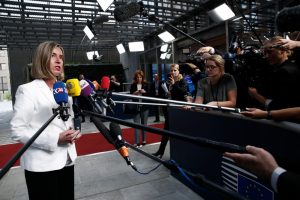by Peter Jenkins
Ten years ago Western diplomats used to scour IAEA (International Atomic Energy Agency) reports on Iran’s “implementation of its NPT Safeguards Agreement” for evidence of safeguards failures that could be used to pressurise Iran into abandoning its fledgling uranium enrichment program.
Today that’s a futile pursuit. The latest IAEA report suggests that Iran is in full compliance with its Nuclear Non-Proliferation Treaty safeguards obligations, and states unequivocally that “the Agency continues to verify the non-diversion of declared nuclear material at nuclear facilities…declared by Iran under its Safeguards Agreement”.
These days Iran’s failings are a consequence of obligations placed upon Iran by the UN Security Council (UNSC). These are different in nature from NPT obligations, since they were not undertaken voluntarily, and since, to create them, the Council had recourse to Chapter VII of the UN Charter, even though conclusive evidence of a threat to international peace was lacking, as was an explicit threat finding by the Council.
Chief among these failings is the inadequacy, in Agency eyes, of Iranian cooperation to resolve concern about “the possible existence in Iran of undisclosed nuclear related activities involving military related organisations”.
Happily, however, there is now movement on what is known as the PMD (Possible Military Dimensions) front. As the report indicates, Iran and the Agency agreed on November 11 to cooperate to resolve “all present and past issues”, and on February 7 they agreed specifically that Iran would provide an explanation for why it had developed Explosive Bridge Wire detonators (which have both civil and military applications).
That is an important step in a hopeful direction. Together with the Agency’s report that Iran is fully implementing all voluntary measures to which it is committed by the November 24, 2013 Joint Plan of Action (JPA), this progress justifies a “so far, so good” inference from the report.
In fact, the report’s only disturbing features are two of the clarifications of intention that Iran has offered pursuant to the JPA – and, almost certainly, these are less disturbing than might at first appear.
In a letter dated February 8, Iran informed the Agency that it plans to build a 10 MW light water research reactor that will require 20% enriched uranium oxide fuel.
A reactor of this type would rank low in any nuclear proliferation risk assessment (unless the assessment were produced in Israel, where the norm seems to be to proclaim any nuclear activity in the region a threat to the future of mankind, unless the activity is undertaken by Israelis).
Still, a putative requirement for 20% enriched uranium fuel cannot be welcome to Western negotiators who embarked on a five-month negotiation with Iran on February18, and who are hoping to persuade Iran to commit to refrain from producing uranium hexafluoride enriched to more than 5% (since the passage from 20% to weapons-grade hexafluoride is quickly made).
However, the fact that Iran will have had no difficulty predicting Western reactions to the mention of 20% suggests that this “plan” is a newly-minted bargaining counter. This would not be the first time that Iran has used technological advances or stated intentions to acquire a little negotiating leverage to offset the massive leverage that the West has acquired through the imposition of sanctions.
A similar calculation probably underlies Iran’s declaration to the Agency on January 18 that it has started the site selection process for five additional enrichment plants. Before Western negotiators succumb to heart failure, they should explore the extent to which Iran is sure that it has a practical need for five more enrichment plants, and the extent to which it might be open to alternative arrangements. That is a discussion the Iranian negotiators will enjoy.
All in all, the report confirms that much useful ground has been covered since the Iranian people had the good sense to elect Hassan Rouhani to be their President in June 2013. Production of 20% hexafluoride has stopped; Iran’s stock of 20% hexafluoride is well below what would be needed to produce sufficient weapons-grade hexafluoride for just one nuclear device; production of 5% hexafluoride has held steady at a low level; Iran has ceased to expand or enhance installed capacity at either of its enrichment plants; the installation of components for a 40 MW reactor that is a legitimate proliferation concern is in abeyance; and Iran has started to resolve residual Agency and UNSC questions about past nuclear-related activities and to shed light on future intentions.
Photo: IAEA Director General Yukiya Amano meets with Iranian Foreign Minister Mohammad Javed Zarif at IAEA headquarters in Vienna on February 18 on the margins of the nuclear-related talks between the P5+1 and Iran. Credit: Dean Calma/IAEA






…..to proclaim any nuclear activity in the region a threat to the future to mankind, unless the activity is undertaken by Israelis. Really now, and so far, the Israelis have their nuclear arsenal, but haven’t used it on anyone, though would/will if they start something that mires them and they can’t sucker the U.S. into bailing them out. This should be made clear without any reservations to Netanyahoo when he visits the U.S. and speaks with “O” privately. Considering that “O” is P.O.T.U.S. as well as C.I.C., while Netanyahoo is the pm of Israel. it’s a no brainier who’s the BOSS.
It should be made clear that the language quoted by Amb. Jenkins about an absence of diversion of nuclear material for nonpeaceful uses, has appeared in every single IAEA report ever issued on Iran.
Iran was always in full compliance with its NPT obligation.
The Safeguards violations that did occur in Iran were unrelated to a weapons program and were resolved to Iran’s favor with still no evidence of any diversion of nuclear material for nonpeaceful uses. Iran justified the violations as a reaction to illegal US interference with its overt and legal nuclear agreements with other nations.